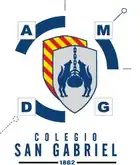| St. Gabriel College Spanish: Colegio San Gabriel | |
|---|---|
 | |
| Address | |
Av. America and Mariana de Jesus Ecuador | |
| Coordinates | 0°11′4.39″S 78°29′44.54″W / 0.1845528°S 78.4957056°W |
| Information | |
| Type | Private primary and secondary school |
| Religious affiliation(s) | Catholic |
| Denomination | Jesuit |
| Established | 1862 |
| Rector | Hno. Guillermo Oñate |
| Director | Martha Peñaherrera |
| Staff | 176 |
| Grades | K-12 |
| Gender | Coeducational |
| Enrollment | 1,491 |
| Website | www |
St. Gabriel College (Spanish: Colegio San Gabriel) is a private Catholic primary and secondary school, located in Quito, Ecuador. The school was founded by the Society of Jesus in 1862, and has grown to include pre-primary as well as six primary and six secondary years.
History
In 1862 President Gabriel García Moreno brought members of a German Jesuits Order to manage the National Polytechnic School and the Quito Astronomical Observatory. That consisted of naturalist Theodor Wolf, astronomer Juan Bautista Menten, architect José Kolberg, José Epping, chemist Luis Dressel and botanist Luis Sodiro.[1] They also opened and managed a school that in colonial times was called under the name San Luis, in the heart of old Quito. They renamed the school, San Gabriel. It was still subsidized by the state, until 1901 when the liberal government forced its privatization. In 1958 it moved to its new facilities on America Avenue in the north of the city. In 2011, San Gabriel opened a coeducational primary unit, beginning with the first grade.
Notable staff
- Fabián Alarcón
- Francisco Tobar García
- José María Velasco Ibarra
- Jorge Salvador Lara
- Jamil Mahuad
- Jaime Nebot
- Fausto Oswaldo Sarmiento - environmentalist[2]
- Clemente Yerovi
See also
References
- ↑ Vivero Lovato, David Alejandro (2018). "Padre Luis Sodiro S. J.: Importancia de su aporte al conocimiento de la botánica en el Ecuador y sus antecesores" (in Spanish). PUCE. Retrieved 18 November 2023.
- ↑ Polunin, Nicholas, ed. (1997). World Who Is Who and Does What in Environment and Conservation. London: Earthscan. p. 287. ISBN 978-1-84971-005-3.